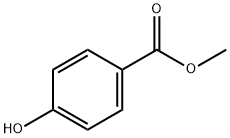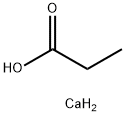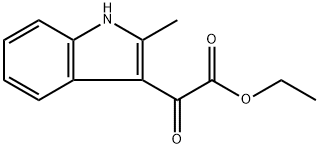Diclofop-methyl
- CAS NO.:51338-27-3
- Empirical Formula: C16H14Cl2O4
- Molecular Weight: 341.19
- MDL number: MFCD00128052
- EINECS: 257-141-8
- SAFETY DATA SHEET (SDS)
- Update Date: 2025-01-27 09:38:02

What is Diclofop-methyl?
Chemical properties
A white crystalline solid. Odorless. Can also be commercially available as a clear to dark brown liquid with a typical solvent odor
The Uses of Diclofop-methyl
Herbicide.
Definition
ChEBI: Methyl 2-[4-(2,4-dichlorophenoxy)phenoxy]propanoate is a methyl ester resulting from the formal condensation of the carboxylic acid group of 2-[4-(2,4-dichlorophenoxy)phenoxy]propanoic acid with methanol. It is an aromatic ether, a dichlorobenzene, a diether and a methyl ester.
General Description
Colorless crystals. Decomposed by either strong acid or base. Used as a selective herbicide.
Air & Water Reactions
Slightly soluble in water (3 mg/l).
Reactivity Profile
A bridged diphenyl.
Hazard
Moderately toxic by ingestion and skin contact. Low toxicity by inhalation.
Agricultural Uses
Herbicide: Some uses are classified as U.S. Restricted Use Pesticide (RUP). Diclofop-methyl is a selective post-emergence herbicide used to control wild oats and annual grassy weeds in grain and vegetable crops: alfalfa, carrots, celery, box, field and french beans, barley, wheat, brassicas, parsnips, peas, potatoes, rapeseed (canola), soy beans, oilseed rape, onions, sugar beets and lettuce.
Trade name
DICHLORDIPHENPROP®; HOELON®; HOELON® 3EC; HOE-GRASS®; HOEGRASS®; HOE® 23408; ILOXAN®; ILLOXAN®; ONE SHOT®[C]
Potential Exposure
Diclofop-methyl is a chlorophenoxy; aryloxyphenoxypropionate acid selective postemergenceherbicide used to control wild oats and annual grassy weeds in grain and vegetable crops: alfalfa, carrots, celery, box, field and French beans, barley, wheat, brassicas, parsnips, peas, potatoes, rapeseed (canola), soy beans, oilseed rape, onions, sugar beets and lettuce. Some uses are classified RUP
Environmental Fate
Biological. From the first-order biotic and abiotic rate constants of diclofop-methyl in estuarine water and sediment/water systems, the estimated biodegradation half-lives were 0.24–12.4 and 0.11–2.2 days, respectively (Walker et al., 1988).
Metabolic pathway
Two resistant biotypes of black-grass (Peldon A1 and Lincs. E1 of Alopecurus myosuroides) exhibit moderately enhanced metabolism of 14C-diclofop methyl. Diclofop methyl is hydrolyzed to the corresponding propionic acid which undergoes further degradation to give polar metabolites. The amounts of the metabolites depend on the metabolism activity of the individual biotypes. In wheat, three isomeric hydroxylated metabolites are identified in a major metabolic pathway after acid hydrolysis of the glucoside conjugates.
Shipping
UN3345 Phenoxyacetic acid derivative pesticide, solid, toxic, Hazard Class: 6.1; Labels: 6.1-Poisonous materials. UN3348 Phenoxyacetic acid derivative pesticide, liquid, toxic, Hazard Class: 6.1; Labels: 6.1-Poisonous material. UN3077 Environmentally hazardous substances, solid, n.o.s., Hazard class: 9; Labels: 9-Miscellaneous hazardous material, Technical Name Required. Note: Commercial product may also be a liquid in a flammable carrier.
Incompatibilities
Incompatible with oxidizers, chlorates nitrates, peroxides, sulfuric acid, caustics, ammonia, aliphatic amines, alkanolamines, isocyanates, alkylene oxides, and epichlorohydrin.
Waste Disposal
In accordance with 40CFR165, follow recommendations for the disposal of pesticides and pesticide containers. Containers must be disposed of properly by following package label directions or by contacting your local or federal environmental control agency, or by contacting your regional EPA office
Properties of Diclofop-methyl
| Melting point: | 39-41°C |
| Boiling point: | 173-175°C (0.1 mbar) |
| Density | 1.3 |
| refractive index | 1.5300 (estimate) |
| storage temp. | 0-6°C |
| form | Solid |
| form | neat |
| color | White to off-white |
| Water Solubility | 0.005 g/100 mL |
| Merck | 13,3109 |
| BRN | 2224754 |
| CAS DataBase Reference | 51338-27-3(CAS DataBase Reference) |
| NIST Chemistry Reference | Propanoic acid, 2-[4-(2,4-dichlorophenoxy)phenoxy]-, methyl ester(51338-27-3) |
| EPA Substance Registry System | Diclofop methyl (51338-27-3) |
Safety information for Diclofop-methyl
| Signal word | Warning |
| Pictogram(s) |
 Exclamation Mark Irritant GHS07  Environment GHS09 |
| GHS Hazard Statements |
H302:Acute toxicity,oral H317:Sensitisation, Skin H410:Hazardous to the aquatic environment, long-term hazard |
| Precautionary Statement Codes |
P261:Avoid breathing dust/fume/gas/mist/vapours/spray. P264:Wash hands thoroughly after handling. P264:Wash skin thouroughly after handling. P273:Avoid release to the environment. P280:Wear protective gloves/protective clothing/eye protection/face protection. P301+P312:IF SWALLOWED: call a POISON CENTER or doctor/physician IF you feel unwell. P302+P352:IF ON SKIN: wash with plenty of soap and water. |
Computed Descriptors for Diclofop-methyl
New Products
3-Iodophenylacetic acid 3-Pyridineacetonitrile, α-hydroxy- 2-Propanamine, 1-chloro-, hydrochloride (9CI) 3-(hexyloxy)-4-(pyridin-3-yl)-1,2,5-thiadiazole 2-Hexyn-1-ol Dibenzo-18-crown-6 Nickel(II) perchlorate hexahydrate, 98% 4-Bromophenylacetonitrile, 95% 3-Bromo-4-fluoroaniline, 97% Sodium tetraborate decahydrate, 98% Palladium(II) acetate, trimer, Pd 99% 4-Bromo-2-chlorotoluene, 97% N N Dimethylformamide Dimethyl Acetal (Dmf Dma) 2,3-Dichloro Benzoyl Cyanide [Side Chain] Bis(2-Chloroethyl) Amine Hydrochloride L-Glutamic Acid Diethyl Ester Hydrochloride 5-(Difluoromethoxy)-2-Mercaptobenzimidazole 1-Ethyl-3-(3-Dimethylaminopropyl)-Carbodiimide Hydrochloride [EDC Hcl] 1,4-Napthoquinone Bromoiodomethane Sodium Bicarbonate Methylene Dichloride (MDC) Ethyl Acetate Indole-3-Carbinol (I3C)Related products of tetrahydrofuran








You may like
-
 17604-74-9 3-Pyridineacetonitrile, α-hydroxy- 98+View Details
17604-74-9 3-Pyridineacetonitrile, α-hydroxy- 98+View Details
17604-74-9 -
 131987-69-4 98+View Details
131987-69-4 98+View Details
131987-69-4 -
 2-Hexyn-1-ol 98+View Details
2-Hexyn-1-ol 98+View Details
764-60-3 -
 Cyclohexane, (2-propynyloxy)- 67967-07-1 98+View Details
Cyclohexane, (2-propynyloxy)- 67967-07-1 98+View Details
67967-07-1 -
 764-60-3 2-Hexyn-1-ol 98+View Details
764-60-3 2-Hexyn-1-ol 98+View Details
764-60-3 -
 2-Propanamine, 1-chloro-, hydrochloride (9CI) 98+View Details
2-Propanamine, 1-chloro-, hydrochloride (9CI) 98+View Details
5968-21-8 -
 3-Iodophenylacetic acid 1878-69-9 98+View Details
3-Iodophenylacetic acid 1878-69-9 98+View Details
1878-69-9 -
 132945-75-6 (S)-1-Boc-3-methanesulfonyloxy-pyrrolidine 98+View Details
132945-75-6 (S)-1-Boc-3-methanesulfonyloxy-pyrrolidine 98+View Details
132945-75-6
